Casino Blackjack: Regole del gioco
Ultimo aggiornamento: 2 settembre 2020Il gioco di blackjack o 21 is the most popular table game offered in casinos. If you are unfamiliar with the rules of casino blackjack or simply need some clarification on the finer points, you’ve come to the right place!
I will tell you everything you need to know to play the game, and also explain the few rules that can differ from one casino to another.
If you are new to casino table games, it can be a bit intimidating the first time that you sit down at a blackjack table. Everything seems to move so fast, and more importantly, everyone else sure seems to know what they are doing!
Don’t worry. It’s really quite easy. Follow along, and you’ll know exactly what to expect at the table.
I migliori casinò online degli Stati Uniti
Parte 1 - Nozioni di base del blackjack
Premessa del gioco
Il blackjack è piuttosto semplice. The basic premise of the game is that you want to have a hand value that is closer to 21 than that of the dealer, without going over 21. Other players at the table are of no concern. Your hand competes only against the hand of the dealer.
The rules of play for the dealer are strictly dictated, leaving no decisions up to the dealer. Therefore, there is no problem with the dealer or any of the other players at the table seeing the cards in your hand. In fact, if you're playing at a shoe game, the player cards are all dealt face up.
In any event, when you're just learning to play, don't hesitate to show the dealer or other players your cards and ask questions.
Valori delle carte
Nel blackjack, le carte sono valutate come segue:
- Un Asso può contare sia come 1 che come 11come spiegato di seguito.
- Le carte dal 2 al 9 sono valutate al loro valore nominale.
- Il Il 10, il Fante, la Regina e il Re hanno tutti un valore pari a 10.
The suits of the cards do not have any meaning in the game. The value of a hand is simply the sum of the point counts of each card in the hand. Alcuni esempi:
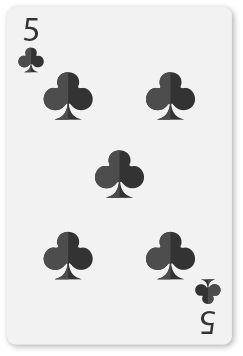
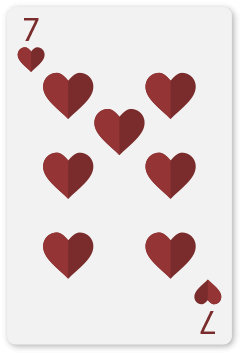

5 + 7 + 9 = 21, quindi questa mano ha un valore pari a 21.
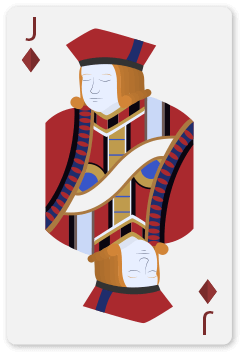
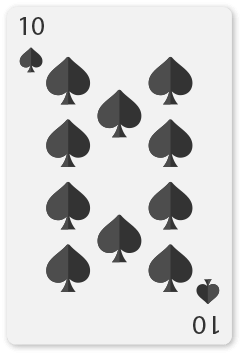
10 + 10 = 20, quindi questa mano ha valore 20.
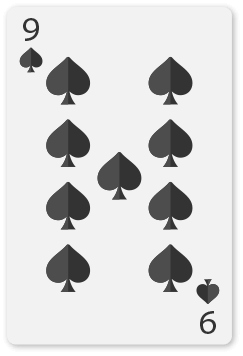
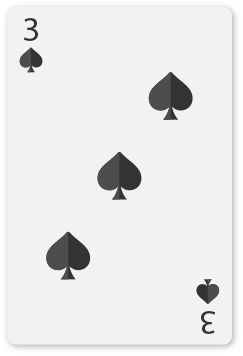
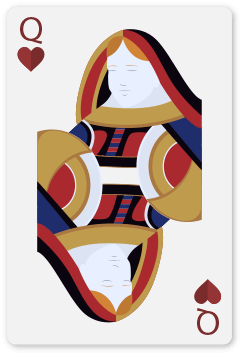
9 + 3 + 10 = 22, quindi questa mano è un "bust". Ogni mano che supera il 21 si "rompe", o è "busted", ed è automaticamente perdente.
Piuttosto facile, eh?
L'Asso aggiunge un nuovo tocco...
An Ace can be counted as either 1 or 11. You need not specify which value the Ace has. It is assumed to have the value that makes the best hand, and that may change as more cards are added to the hand.


Questa mano ha un valore di 7 o 17, noto anche come 17 "morbido".
A soft hand is any hand where an Ace can be counted as either 1 or 11 without going over 21. The name reflects the fact that the hand can't break if you draw another card. It's "soft".
Pesciamo un'altra carta:


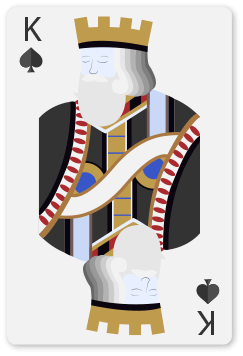
Now our hand is 17, since 1 + 6 + 10 = 17. We no longer have the option to count the Ace as 11, because that would go over 21. (This hand is now a hard 17, despite having an Ace in it.)
Facciamo marcia indietro e peschiamo invece una carta diversa:



Ora la nostra mano è "10 o 20", un 20 morbido. Il 20 è un'ottima mano, quindi ci fermiamo qui.
Il gioco delle carte
Once all the bets are placed, the dealer will deal the cards to the players. He will make two passes around the table starting at his left (your right) so that the players and the dealer all have two cards each. The dealer will flip one of his cards over, exposing its value as the "dealer upcard".
(In alcune parti del mondo, il mazziere può ricevere una sola carta. Ne parlerò tra poco).
In games dealt from a shoe, the players' cards will be face-up, and players are not allowed to touch the cards. If you are just beginning, this is the best kind of game, because you don't have to worry about handling the cards.
Hand-held games are slightly different. In these games, the players' cards are dealt face down, and players pick up the cards. When handling the cards in a hand-held game, here are a few important things to remember.
- You must only touch the cards with one hand. If you are a poker player, this can take some effort to break old habits!
- Le carte devono essere tenute sopra il tavolo. Non avvicinatele al corpo.
- Any cards that the dealer subsequently deals to your hand are left on the table, not added to the cards you are holding.
Once the initial hands are dealt, play proceeds around the table starting at the first seat to the dealer's left, also called "first base". Each player in turn indicates to the dealer how he wishes to play the hand. (All of those choices are explained in the next part of this series.)
After all of the players have finished their hands, the dealer will complete his hand, and then pay the winning bets and collect the losing bets.
Come il mazziere gioca la sua mano
The dealer will first flip over the "hole card" to reveal his two-card starting hand. The dealer is then required to play his hand in a very specific way, with no choices allowed.
Deve pescare carte finché non ha un totale di 17 o più. The dealer has no choice in how to play the hand. He must continue taking cards until his total is at least 17. (A slight variation of this rule is discussed below.)
Analizziamo una possibile mano del mazziere:

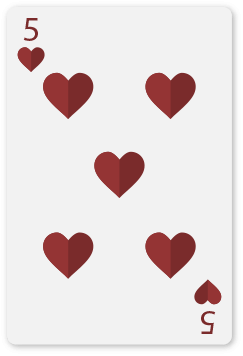

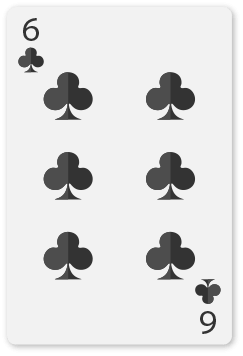
After flipping over the hole card, the dealer's hand was (Ace, 5). That makes a hand value of 16, so he must draw another card.
He drew a 7, making the hand value 13 (the Ace can no longer be counted as 11). With a total of 13, he must hit again.
He drew a 6, making the hand total 19. Since that is "17 or more", the dealer stops with a final total of 19.
Vittorie, sconfitte e pareggi
Una volta terminata la mano, come fa il croupier a decidere quali puntate pagare e quali riscuotere?
If you draw a card that makes your hand total go over 21, your hand is a bust. That is an automatic loser. The dealer will immediately collect your bet, and discard your hand.
Supponendo che non abbiate bustato, il dealer giocherà la sua mano alla fine. Se il giocatore fallisce superando il 21, tutti gli altri giocatori vincono le loro puntate.
Se né voi né il mazziere avete fatto busted, ora il mazziere confronterà il suo totale finale con il vostro.
If his total is higher than yours, you lose the bet, and he will collect your bet and put the chips in his tray.
If your total is higher than his, you win the bet, and he will pay the entire amount you have bet. After he pays you, you'll have your initial bet plus the amount you won in the circle.
Quindi, cosa succede se voi e il banco pareggiate, con lo stesso identico totale? Niente di niente. Un pareggio è chiamato "push" e non si vince o si perde la scommessa. Your chips stay in the betting circle where you can leave them for the next hand if you want, or you can add to or remove from them as you wish before the next hand.
Che cos'è un Blackjack, o Naturale?
Un blackjack, o naturale, è un totale di 21 nelle prime due carte.. A blackjack is therefore an Ace and any ten-valued card, with the additional requirement that these be your first two cards. If you split a pair of Aces for example, and then draw a ten-valued card on one of the Aces, this is not a blackjack, but rather a total of 21.
The distinction is important, because a winning blackjack pays the player at 3 to 2. A bet of $10 wins $15 if the player draws a blackjack. A player blackjack beats any dealer total other than blackjack, including a dealer's three or more card 21. Se sia il giocatore che il banco hanno un blackjack, la mano è un pareggio o un push.
The dealer will usually pay your winning blackjack bet immediately when it is your turn to play. In the face down games, this means that you should show the blackjack to the dealer at that time. Some casinos may postpone paying the blackjack until after the hand is over if the dealer has a 10 card up and has not checked for a dealer blackjack. Other casinos check under both 10 and Ace dealer upcards, and would therefore pay the blackjack immediately.
Regardless, when you are dealt a blackjack, turn the cards face up, and smile. It only happens about once every 21 hands, but it accounts for a lot of the fun of the game.
Parte 2 - Scelte del giocatore
Colpire e stare in piedi
The most common decision a player must make during the game is whether to draw another card to the hand ("hit"), or stop at the current total ("stand").
You will be required to make hand signals rather than just announcing "hit" or "stand" to the dealer. This is to eliminate any confusion or ambiguity in what you choose, and also for the benefit of the ever-present surveillance cameras. If you go over 21, or "bust", the dealer will collect your bet and remove your cards from the table immediately.
Il modo in cui si segnala la propria intenzione al mazziere dipende dallo stile di gioco:
Segnali di mano nel gioco della scarpa
In the face-up shoe game, you indicate that you want another card by tapping the table behind your cards with a finger.
When you decide to stand, just wave your hand in a horizontal motion over your cards.
Ricordate che in questo tipo di gioco non è consentito toccare le carte.
Segnali di mano nel gioco a mano
In the face-down game, things are a little different. You will hold the first two cards with one hand.
To let the dealer know that you want to draw another card to your hand, scratch the table with the bottom of your cards lightly. Watch another player at first to see how this works. The dealer will deal your additional cards on the table in front of your bet. Leave those cards on the table, but mentally add them to your total hand value. If you go over 21, just toss the two cards in your hand face up on the table. The dealer will collect your bet and discard your hand.
When you decide to stand, tuck the two cards you are holding face-down under the chips in your betting circle. Le prime volte può essere un po' complicato. Non prendere la puntata per posizionare le carte sottostanti. Ricordate che una volta distribuite le carte, non potete toccare le fiches nel cerchio. Simply slide the corner of the cards under the chips.
Describing these moves makes them sound complicated. They're not. Just pay attention to what other players are doing and you will fit right in.
Raddoppiare
Much of the excitement and profit in blackjack comes from hands where you are able to "double down". This option is available only with a two card hand, before another card has been drawn. Doubling down allows you to double your bet and receive one (and only one) additional card to your hand.
A good example of a doubling opportunity is when you hold a total of 11, like a (6,5) against a dealer's upcard of 5. In this case, you have a good chance of winning the hand by drawing one additional card, so you should increase your bet in this advantageous situation by doubling down.
If you are playing in a hand-held game, just toss your original two cards face-up on the table in front of your bet.
In entrambi i tipi di gioco, aggiungere una puntata supplementare al cerchio delle scommesse. Piazzare la puntata aggiuntiva adiacente alla puntata originale, non sopra di essa.
The dealer will deal one additional card to the hand. In a shoe game, he will probably deal the card sideways to indicate that this was a double-down. In a hand-held game, the card will be tucked face-down under your bet to be revealed after the hand is over. Depending on what the dealer makes on his hand, it can be an exciting wait to see that card revealed at the end!
You are allowed to double down for any amount up to your original bet amount, so you could actually double down for less if you wanted. That's a bad move though. Remember that you do give up something for being allowed to increase your bet: the ability to draw more than one additional card. If the correct play is to double down, you should always double for the full amount if possible.
E quando è il caso di raddoppiare, vi chiederete? Per saperlo, basta usare il nostro Motore della strategia di base del blackjack.
Dividere le coppie
When you are dealt a pair of cards of the same rank, you are allowed to split the pair into two separate hands and play them independently. Let's say you are dealt a pair of eights for a total of sixteen. Sixteen is the worst possible player hand, since it is unlikely to win as is, but is very likely to bust if you draw to it. Here's a great chance to improve a bad situation.
If you are playing a hand-held game, toss the cards face-up in front of your bet just like a double down. Then, in either type of game, place a matching bet beside the original bet in the circle. Note that you must bet the same amount on a split, unlike a double-down where you are allowed to double for less.
The dealer will separate the two cards, and treat them as two independent hands. He will deal a second card on the first eight, and you will play that two-card hand to completion. (Many casinos will let you double-down on that two-card hand if you want. I will discuss the "Double After Split" option in Variazioni della regola.)
No matter what happens on your first hand, when you are done with it the dealer will deal a second card to your next hand and the process starts all over.
Resplitting
If you get additional pairs in the first two cards of a hand, most casinos will allow you to resplit, making yet another hand. Typically a player is allowed to split up to 3 times, making 4 separate hands, with 4 separate bets. If double after split is allowed, you could have up to 8 times your initial bet on the table!
Dividere le decine
Note that you are allowed to split any 10-valued cards, so you could split a (Jack, Queen) hand. However, this is usually a bad play. Keep the 20. You will make more money on the pat 20 than you will trying to make two good hands from it.
Non siete convinti? Ho scritto un post proprio su questo: Perché dividere le decine è una mossa sbagliata.
Assi divisi
Another oddity comes when splitting Aces. Splitting Aces is a very strong player move so the casino limits you to drawing only one additional card on each Ace. Also, if you draw a ten-valued card on one of your split Aces, the hand is not considered a Blackjack, but is instead treated as a normal 21, and therefore does not collect a 3:2 payoff.
Alcuni casinò consentono di ripetere l'estrazione di un Asso se ne viene estratto un altro, ma molti non lo fanno.
Con tutte queste limitazioni, ci si può chiedere se abbia senso dividere gli Assi.
La risposta è una sonora
SÌ.
Dividere sempre gli Assi.
Per avere consigli precisi su quali altre coppie è opportuno dividere, consultare il sito web Motore della strategia di base del blackjack.
Parte 3 - Strategia di base
Se si vuole vincere al Blackjack, è necessario imparare la strategia di base da un grafico di strategia di base o giocare con il interactive strategy trainer. However, there are some quick rules and tips that you can learn as a beginner to decrease the house edge and formulate a strategy.
Quando colpire o stare nel blackjack
- 1: Mai un 17 o più.
- 2: Mai stare su un 11 o più basso.
- 3: Mai colpire un 12-16 contro un 4, 5 o 6 del banco.
- 3: Sempre colpire un 12-16 contro un 7 o più del banco.
- 4: Sempre colpire su soft 17 o meno.
Quando raddoppiare nel blackjack
Remember there are more 10 value cards (10, J, Q, K) than any other cards in the deck—so when a 10 will get you close to 21 and you are against a card that is bad for the dealer, you should double. A player 9, 10, or 11 would always be a good double when a dealer is showing a 3, 4, 5, or 6. This is because the 3, 4, 5, and 6 are starting cards that are more likely to make a dealer bust.
- 1: Sempre raddoppiare un 9 contro un 3, 4, 5 o 6.
- 2: Sempre raddoppiare un 10 contro qualsiasi carta del banco che non sia un 10 o un Asso.
- 3: Sempre raddoppiare un 11 contro qualsiasi carta del banco che non sia un Asso.
- 3: Sempre raddoppiare un 18 morbido o inferiore contro un 5 o 6.
Quando dividere nel blackjack
1: Dividere sempre gli Assi e gli 8.The Ace is such a powerful card because pulling a 10 on a split will give you a 21. Even though a 21 gained through a split is still only paid 1:1, it is a very advantageous situation. Splitting 8’s is important because it rids you of a 16—the worst hand in Blackjack.
2: Non dividere mai i cinque o le facce.Two fives total 10—which is a hand much better suited for doubling. Face cards or 10’s should not be split because they already total 20, which is a great hand on its own.
Parte 4 - Assicurazione e riscatto
Assicurazione
Insurance in blackjack is often misunderstood by players, and is a big money-maker for casinos. Naming this side-bet "insurance" was a brilliant marketing ploy, and some otherwise solid players will frequently make this bad bet to "insure" when they have a good hand. But actually, insurance is not always a bad bet. For players who can recognize when the remaining deck is rich in ten-valued cards, this can actually be a profitable side-bet.
Ma cos'è esattamente l'"assicurazione" nel blackjack?
Insurance is a proposition bet that is available only when the dealer's upcard is an Ace.
When the dealer turns up an Ace, he will offer "Insurance" to the players. Insurance bets can be made by betting up to half your original bet amount in the insurance betting stripe in front of your bet.
The dealer will check to see if he has a 10-value card underneath his Ace, and if he does have Blackjack, your winning Insurance bet will be paid at odds of 2:1. You will still lose your original bet (unless you also have a Blackjack), so the net effect is that you break even (assuming you bet the full half bet for insurance.) This is why the bet is described as "insurance", since it seems to protect your original bet against a dealer blackjack. Of course, if the dealer does not have blackjack, you'll lose the insurance bet, and still have to play the original bet out.
Insurance is simply a side-bet offering 2:1 odds that the dealer has a 10-valued card underneath their Ace. Not surprisingly, the casino has a substantial edge on this bet. In a single deck game, there are 16 ten-valued cards. Assuming that you don't see any other cards, including your own, the tens compose 16 out of 51 remaining cards after the dealer's Ace was removed. For the insurance bet to be a break-even bet, the hole card would have to be a ten 1 out of 3 times, but 16/51 is only 1 in 3.1875.
That creates a 5.88% house edge on the insurance bet in single deck. It's even worse in six decks with a 7.40% house edge.
Card counters can still beat the insurance bet, by only making the bet when they know that more than one-third of the remaining cards are tens.
Unless you are card counter and know the deck is skewed sufficiently, just ignore the insurance bet. It doesn't matter whether you have a good hand or a bad hand.
Prendere "soldi pari" al Blackjack
If you have a blackjack when the dealer turns up an Ace, he is likely to offer you "even money" instead of the insurance bet. If you accept, the dealer will pay you the amount of your original bet and discard your hand of blackjack, before he even checks under his Ace to see if he has a blackjack as well.
Many players think this sounds like a good deal, guaranteeing a profit even if the dealer has a blackjack. But that guaranteed profit comes at a price. You will win more money in the long run by holding out for the full $15 payout when the dealer does not have blackjack, even though you will sometimes end up empty-handed.
"Even money" is nothing but an insurance bet on your blackjack, nothing more and nothing less. Let me show you how it works:
Let's say you bet $10, and have a Blackjack. You would normally collect $15 for this, unless the dealer also has a blackjack in which case you push or tie. Let's assume that the dealer has an Ace up, and you decide to take insurance for the full amount allowed of $5.
Ora, possono accadere due cose:
- The dealer has a Blackjack. You tie with the $10, but collect 2:1 on the $5 insurance bet for a total profit of $10.
- The dealer does not have Blackjack. You lose the $5 insurance bet, but collect $15 for your blackjack. Your total profit is again $10.
In either case, once you make the insurance bet you are guaranteed a profit of $10, which is an even money payout for your original bet. So, casinos allow you to eliminate the insurance bet altogether, and simply declare that you want "even money" for your blackjack when the dealer has an Ace showing.
The problem is that you are still making a bad bet on insurance, which costs you money. If you ignore the offer of even money, sometimes you get $15, and sometimes you get $0. But on average, you will collect slightly more than the $10 you are offered for even money.
A player who does not count cards should simply never take the insurance bet, even the "even money" variety.
Arrendersi
Some games offer the player a chance to fold their hand, and forfeit half of their bet. This surrender option must be done as the very first action the player takes on the hand. In other words, you can't draw a card and then decide to bail out!
Even when surrender is available, it is rarely used by players. Often, the rules posted at the table won't mention it even if the casino allows it. And many players just don't like the idea of surrendering a hand. But for a smart player, it is a useful option, and reduces the house advantage by about 0.08%.
When surrender is available, make sure you know the correct strategy for using it. Most players who use the option surrender too many hands. If your game offers surrender, I recommend reading my spiegazione completa della resa del blackjack.
In the most common variety (known as "late" surrender), a player cannot surrender until after the dealer has checked for blackjack. If the dealer has blackjack, you will lose your entire bet with no chance of surrendering for half the cost.
Parte 5 - Variazioni delle regole
Nel blackjack esistono alcune regole che possono variare leggermente da casinò a casinò.
Il mazziere colpisce un 17 morbido
Generally, the dealer in blackjack must hit if he has a total of 16 or less, and stand if he has 17 or more.
Ma in alcuni giochi c'è un'eccezione quando il banco ha una mano di 17 "soft".
Se guardate il tavolo, vedrete una delle due frasi sul feltro:
- Il mazziere si ferma su tutti i 17: This is the simple version. The dealer will stand with any total of 17 or more, whether that total is "soft" or not. (This rule is abbreviated S17. The S is for Stand, not Soft!)
- Il mazziere colpisce un 17 morbido: In casinos with this rule, the dealer will stand with any hard 17, but draw another card if he has a soft 17, such as (Ace, 2, 4). (This rule is abbreviated H17.)
Seventeen is a weak hand, so if the dealer is allowed to try to improve the soft 17 hands, it makes the game tougher. When a dealer is allowed to hit soft 17, it adds about 0.2% to the house advantage.
Years ago, the only "Hit Soft 17" games in the US were in and around Reno, Nevada. Almost all other areas used the better rule of standing on all 17s. Over the years, more and more casinos have switched to hitting soft 17, and there are now far more H17 games than S17 games.
You can still find some games where the dealer stands on all 17s, even in casinos where some of the tables use the H17 rule. Look around!
Doppio dopo la divisione
After splitting a pair, many casinos will allow you to double-down on a two-card hand that arises as a result of the split. For example, if you split a pair of eights, and draw a 3 on the first hand, it is valuable to be able to double-down on the resulting hand of 11.
Questa regola è abbastanza comune e aiuta il giocatore di circa 0,12%.
Ripetizione degli assi
As mentioned in the previous section discussion on pair splitting, there are several common restrictions on splitting Aces. You will receive only one card on each Ace after splitting.
Some casinos will allow you to resplit if you draw another Ace, and some will not. That's true even if the casino allows resplits of all other pairs.
Quando il casinò permette il resplitting degli Assi, aiuta il giocatore di circa 0,08%.
This rule is rarely posted at the table. If you are curious, you will need to ask the dealer.
Peek or No-Peek, Hole Card or No Hole Card
Many casinos in Europe, and some in other parts of the world, handle the dealer's second card differently. In these "European No Hole Card" games, the dealer only deals himself one card at the beginning of the round. After all the players have completed their hands, he deals his own second card and completes the hand.
In contrasto con il normale stile di gioco degli Stati Uniti. There, if the dealer has a ten or Ace card up, he checks the other card immediately to see if he has a blackjack. If he does, the hand is over. This process of "peeking" under the hole card to check for blackjack means that players can only lose one bet per hand if the dealer has a blackjack.
In a No-Hole-Card game, a player might split or double and have multiple bets at risk to a dealer blackjack, because the dealer cannot check ahead of time. This changes the optimal strategy, and means that players should usually not split or double against a dealer ten or Ace upcard. (An exception is splitting Aces against a dealer ten.)
Note that there are a few no-hole-card games where the rules specifically say that only one bet will be collected from a player if the dealer has a blackjack. In those games, although there is no hole card, you can play the game as if there were. (That means you should play it as a Peek game, even though there's not really a peek!) It's all a bit confusing.
Quando è in uso la regola No-Hole-Card e tutte le puntate sono a rischio per un blackjack del banco, costa al giocatore 0,11%, and players should revise their strategy appropriately. (Use the "No-Peek" option at our Motore strategico.)
Il Charlie delle cinque carte
Ok this one's an extremely rare variation which I doubt you will see in any casinos today but I thought I'd mention. If the player draws 5 cards and doesn't bust then he/she automatically wins the hand (this is called a "Charlie").
Similarly there is a rule variation whereby the player automatically wins when drawing 7 cards without busting which is called a "Seven Card Charlie".
Part 6 – Playing at the Casino Basics
Scegliere un tavolo al casinò
If you are new to the game, there are a few items you should notice when looking for a game…
The most important item is the sign declaring betting limits. If you are reading this, you probably don't want to sit down at a table that requires a $100 minimum bet! Both the minimum and the maximum allowable bets should be on a sign on the table-top. Look around to find a table that suits your bet sizes.
Make sure that the table you have selected is actually for blackjack, and not another of the many kinds of table games that casinos offer. Look on the table for the phrase " Il blackjack paga 3 a 2". Evitate tutti i giochi che dicono " Il blackjack paga da 6 a 5" invece. (Vedi Blackjack 6 a 5? Dite semplicemente no!.)
Next, take a look at how the game is being dealt. There are two different dealing styles:
- Giochi di scarpe: The dealer distributes cards from a dealing shoe and the player cards are all dealt face-up. These games typically use 6 or 8 decks of cards.
- Giochi portatili: The dealer holds the cards in his hand and usually deals the player cards face-down. These games typically use 1 or 2 decks of cards.
I principianti dovrebbero iniziare con i giochi di scarpe. The advantage in this style is that all of the players' cards are dealt face-up, so the dealer and other players can easily help you with playing questions and decisions. Once you become proficient at the game, you may want to switch to a game with fewer decks since that lowers the casino's advantage.
Acquisto di patatine
To play the game, you will need to exchange some cash for chips from the dealer.
Wait for a break in the action, and place your cash out in front of you on the table felt.
In questo caso valgono alcune regole del galateo:
- Don't try to hand your money to the dealer. For security reasons, he can't take anything from your hands. Just lay it on the table instead.
- Don't put it into the betting circle, as some casinos will allow cash bets, and the dealer may think you want to bet it all!
- Buy in for at least enough cash to play several hands. A typical $5 player might buy in for $40 or so.
The dealer will exchange the entire amount of cash for the equivalent in chips, and drop the cash into a box on the table.
Date una rapida occhiata alle fiches per assicurarvi di conoscere il valore di ciascun colore. Common chip colors are red for $5, green for $25, and black for $100.
If you have any questions, just ask the dealer. Part of his job is to help players learn the game.
Piazzare una scommessa
Once you are ready to place a bet, wait for the current hand to be completed, then push your bet into the betting circle.
Your chips should be in one stack. If you are betting multiple denominations of chips, place the larger valued chips on the bottom of the stack, and the smaller value chips on top.
Once the cards have been dealt, you are not allowed to touch the bet in the circle. If you need to know how much you have bet for doubling or splitting (explained later), the dealer will count down the chips for you.
Once the hand is over, the dealer will move around the table to each position in turn, paying winning hands and collecting the chips from losing hands. After the dealer has paid you, you can remove your chips from the circle, and place your next bet.
If you want to let your winnings ride, you will need to form one stack of chips from the two or more stacks on the table after the dealer pays you. Remember, higher value chips should be placed on the bottom of the stack.
Incasso delle fiches
When you are ready to leave the table, you do not cash in your chips the same way you bought them. The dealer cannot give you cash for the chips at the table. To do that, you must take the chips to the casino cashier.
If you have a lot of low denomination chips in front of you at the table, you should trade them for the equivalent higher value chips instead. In between hands, just tell the dealer you want to "color up", and he will have you push your chips into the middle of the table. He will count them down, and give you a smaller stack of chips that amount to the same value. This makes them easier to carry for you, and for the dealer it maintains his supply of smaller chips.
Now you can take those chips to another table for more play, or head to the casino cashier where you can exchange them for cash.
FAQ
Per niente. A differenza di altri giochi di carte, i semi non hanno alcun peso nella valutazione delle carte.
Sì! Leggi il nostro articolo sul conteggio delle carte per maggiori informazioni
Cosa c'è dopo
So, if you have made it this far, congratulations. You should have a good idea of what to expect when you sit down at a blackjack table in the casino.
What we have not talked about is how to actually make the best decisions while playing the game. That is a whole subject all its own. To have the best chance of winning, you should learn and practice "basic strategy", which is the mathematically best way to play each hand against each possible dealer upcard.
Per un grafico gratuito che mostra il gioco giusto in ogni caso, visitate il nostro sito web Blackjack Basic Strategy Engine.
Siete sulla buona strada.
Play Online for Real Money
Se desiderate giocare comodamente da casa vostra, potete visitare il nostro sito blackjack online o live dealer blackjack per ulteriori risorse.
Hopefully I've covered just about everything you need. But if you have other questions, feel free to post a reply at the bottom of the page.
Mentre siete qui, date un'occhiata ad alcune delle nostre funzioni più popolari:
Volete esercitarvi? Il nostro gioco del blackjack gratuito lets you play at your pace, and the Strategy Coach provides instant feedback on the best strategy.
To find the best strategy, use our most popular resource: The Motore di strategia del blackjack fornisce grafici strategici gratuiti ottimizzati per le vostre regole esatte.
If you prefer a plastic card that you can take to the table with you, we have those too: Carte della strategia di base del blackjack.





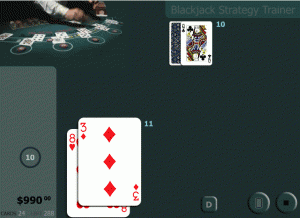
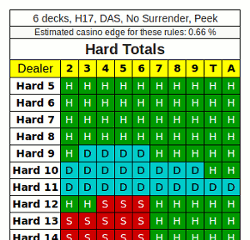
Mi dica, per favore, quante caselle puntare quando si gioca a blackjack?
Salve, sono nuovo di questo gioco e non sono sicuro di quale schema di strategia di base memorizzare. Giocherò a Wendover. Ci sono giochi a singolo, doppio e 6 mazzi. Cosa mi consiglieresti per un principiante?
Iniziare con la strategia dei 6 mazzi, con il dealer che colpisce il 17 morbido.
Ok. Grazie. Stavo cercando di imparare tutti e tre e mi stavo confondendo, quindi grazie.
Sembra che io abbia fatto delle scelte sbagliate da anni ormai, pensavo che dividere i dieci contro qualsiasi cosa che non fosse un asso o un 10 fosse una buona mossa :/
Grazie per avermi chiarito le idee!
Ero un po' nervoso all'idea di andare al casinò e di sbagliare i segnali manuali, quindi grazie per avermi chiarito questo punto. Ottimo articolo
Cosa significa la luce rossa sul tavolo del black jack?
A quale luce rossa si riferisce?
Un Black Jack e una Regina rossa sono un Blackjack?
No, perché il blackjack e la regina rossa hanno entrambi un valore di 10, che si somma solo a 20.
Il conteggio delle carte è legale?
Naturalmente, sì.
Se un giocatore decide di stare su 15 per qualsiasi motivo e il mazziere ha 16, deve comunque pescare un'altra carta visto che è inferiore a 17?
Sì
stavo giocando a black jack al casinò di sudbury. quando ho diviso due carte faccia la macchina mi ha permesso di giocare ogni carta separatamente come due mani separate ma quando ho diviso due assi la macchina mi ha dato una carta su ogni asso e poi ha giocato la sua mano non permettendomi di giocare gli assi a tutti. è una pratica comune.
Sì, di solito si può ottenere solo una carta aggiuntiva per ogni mano quando si dividono gli assi.
Se il dealer ha il black jack e dice di non averlo, il gioco continua e anche tu ottieni 21, qual è il ricorso?
Penso che perderesti
Ken Smith. C'è qualche significato nel blackjack quando si ha un fante nero accoppiato con un asso nero, dello stesso seme? La domanda è emersa nella domanda a scelta multipla di Millionaire. "Con 8 mazzi nella scarpa, quanti fanti neri ci sono? Ho indovinato 16, ma la risposta era 32".
Nessun significato.
Un blackjack appare in media circa una volta ogni 21 mani.
4×8=32
Questo perché si intendeva quante possibili mani di jack nero, non di jack "nero".
Nel gioco del 21 con un mazzo di carte e due persone che giocano, nel gioco del Blackjack con un mazzo di carte e due persone che giocano, qual è il black jack che si presenta di più?
Non credo che sia importante quante persone stiano giocando, se il mazzo è solo uno il blackjack potrebbe apparire solo 4 volte, una per ogni Asso del mazzo.
In un mazzo di carte con due persone che giocano, qual è la maggior parte delle carte nere?
I blackjack compaiono circa una volta ogni 21 mani.
Non a Oz
Ken,
Forse questa non è la pagina più appropriata per postare questo messaggio, ma lasciatemi spiegare la situazione. Aspiro a riunire un gruppo di ragazzi fidati per formare una squadra di blackjack. A meno che non mi sia sfuggito, non vedo nulla in questo sito che parli del gioco di squadra. Ci vorrà un bel po' di tempo prima che io possa effettivamente mettere in atto questo piano, ma ho numerosi dettagli già elaborati nella mia testa e vorrei sottoporli a un professionista per ottenere alcuni suggerimenti e consigli.Ho letto diversi articoli online che parlano del gioco di squadra, ma ci sono risorse o riferimenti che potete darmi? E se sei disposto e/o hai tempo, potrei in qualche modo discutere con te alcune delle mie idee specifiche? Sarebbe sufficiente conoscere una buona fonte online o un buon libro su cui poter mettere le mani. Grazie.
Il gioco di squadra è complicato e molto più complesso di un gruppo di amici che mettono in comune le risorse. Non ci sono molte pubblicazioni sul gioco di squadra. Il seguente libro può essere utile.
https://www.lasvegasadvisor.com/shop/products/blackjack-blueprint/
Me lo sono sempre chiesto ed è la strada da percorrere.
In un blackjack base, il triplo 7 suited viene pagato 3xs?
A meno che il casinò non abbia una promozione speciale.
Che effetto ha sul gioco se il giocatore può dividersi solo una volta e non più volte?
La strategia non cambia, ma il giocatore peggiora di circa 0,1% se non è consentito il resplit.
Supponiamo che io sia il mazziere e che abbia due giocatori, il giocatore a sinistra ha 18 e rimane e l'altro giocatore a destra ha 21. In qualità di croupier, arrivo a 20. Il dealer può scegliere di rimanere e prendere le fiches puntate dal giocatore di sinistra. Ma pagare il giocatore di destra?
Il banco non può SCEGLIERE di fare qualcosa. Le sue regole sono fisse. Deve colpire finché non ha 17 o un valore superiore, e poi deve stare. Anche se tutti i giocatori al tavolo hanno 18, il mazziere deve stare se finisce con 17.
Una complicazione: La maggior parte dei casinò ora offre giochi con una regola aggiuntiva sui 17 morbidi. Nei giochi "Dealer Hits Soft 17", se il banco ha una mano come (Asso,3,3), si tratta di un 17 "soft" e deve colpire di nuovo. Questo aspetto è trattato in dettaglio nell'articolo precedente.
Nel tuo esempio particolare, il banco deve ovviamente stare in piedi con un totale di 20, e raccoglierà le fiches dal giocatore con 18, e pagherà il giocatore con 21.
Ho una domanda. Sono solo un giocatore principiante, ma è 8 il numero massimo di mazzi che è consentito utilizzare in una partita di blackjack originale? Mi sono iscritto a un casinò online e mi stavo preparando a giocare a blackjack con soldi veri e ho chiesto alla persona che mi ha aiutato nella chat dal vivo quanti mazzi venivano usati e lei mi ha risposto 24 mazzi. È consentito?
I casinò, sia online che terrestri, possono gestire il gioco in qualsiasi modo, compreso l'aumento del numero di mazzi fino alla ridicola cifra di 24! Fortunatamente, una volta arrivati a 8 mazzi, il gioco non peggiora molto per il giocatore aggiungendo altri mazzi. In effetti, ci sono stati casinò online che hanno distribuito da mazzi "infiniti", il che significa semplicemente che la probabilità che ogni rango di carte venga distribuito è sempre 1 su 13.
Per un giocatore di strategia di base, non influisce molto sul gioco passare da 8 a 24 mazzi o addirittura a infiniti mazzi. Utilizzate la strategia a 8 mazzi per queste partite.
Otto mazzi è il numero più comune nei casinò tradizionali, ma nella maggior parte delle giurisdizioni, terrestri o online, non esiste un requisito legale per un numero specifico di mazzi.
C'è uno standard nel modo in cui il dealer distribuisce il mazzo? So che i casinò usano più mazzi e li distribuiscono fino a esaurirli. Tuttavia, ultimamente ho notato che dopo ogni mano prendono le carte e le mettono in una macchina per mescolare, in modo che non si possa vedere quante carte sono rimaste finché non si raggiunge la fine del mazzo. In realtà non conto le carte, ma mi faccio un'idea di ciò che sta accadendo osservando ciò che è stato giocato e ciò che resta da distribuire. È consentito? Dato che ho appena posto questa domanda, suppongo che sia tutto ciò che il casinò vuole fare, ma non ci sono delle linee guida che devono seguire?
Lei sta descrivendo una CSM (continuous shuffle machine), in cui dopo ogni mano il dealer rimette immediatamente le carte usate nel mescolatore. Come lei nota, questo elimina la possibilità di contare le carte o di osservare un bias utile. Poiché le carte usate possono tornare in gioco immediatamente, la penetrazione è di fatto nulla. Queste macchine si sono diffuse ampiamente. L'unica possibilità è quella di verificare se il vostro casinò offre ancora giochi normali (a mano o a macchina ma con un normale vassoio degli scarti). In caso contrario, esprimete il vostro malcontento e cercate altrove.
Inoltre, ho provato a scrivere a un casinò un paio di volte per conoscere le loro regole particolari del blackjack. Nessuna risposta. Dovrei essere in grado di chiedere a un casinò di fornire una copia delle loro regole?
Immagino che stiate parlando di casinò online. Consiglierei di evitare qualsiasi posto che non abbia le regole chiaramente disponibili sul proprio sito. Certamente, se non rispondono alle richieste di regole, questo è tutto ciò che dovrei sapere sul loro livello di supporto. Non se ne parla!